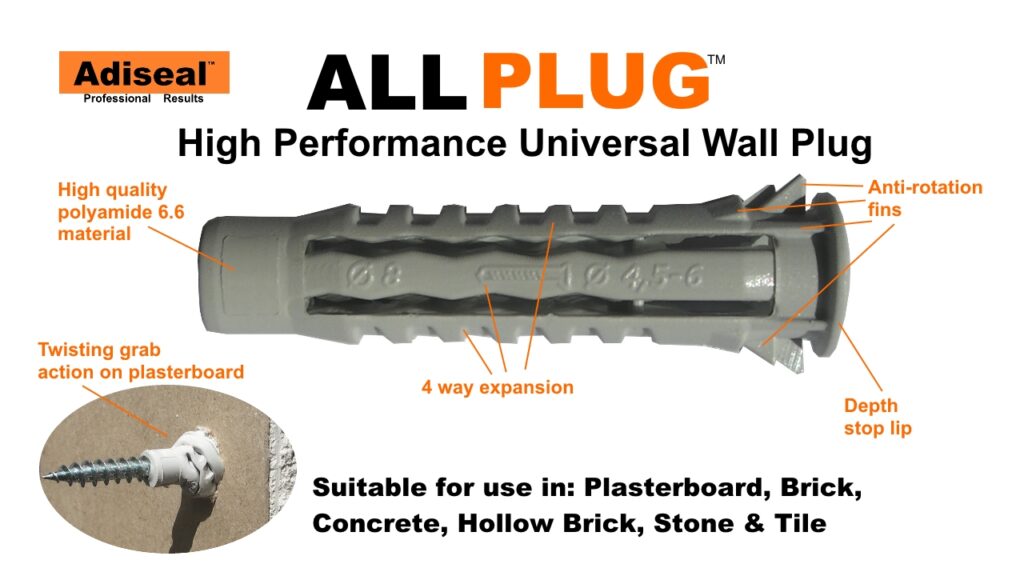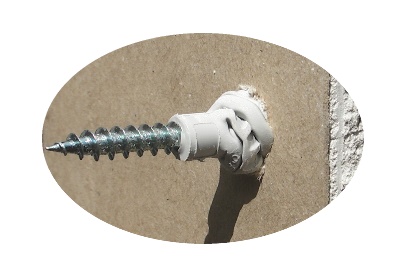Wall Plugs for Plasterboard
Wall Plugs for Plasterboard
To fix an item to plasterboard requires special wall plugs for plasterboard. Not all wall plugs are suitable for use as drywall anchors. Standard wall plugs in plasterboard will not provide a strong fixing as they are not designed for this purpose. There are plasterboard fixings that are specifically designed for this application and will provide a much stronger and heavy duty fixing in plasterboard.
There are products that are designed to work on plasterboard only. Other products are multipurpose and will also work on solid materials as well as a drywall anchor. How to use plasterboard fixings and the different types of plasterboard fixings will also be looked at on this page.
- AllPlug wall plugs in plasterboard
- How AllPlug works in fixing to plasterboard
- How to use plasterboard fixings
- Types of plasterboard fixings
- Where to buy wall plugs for plasterboard

AllPlug wall plugs in plasterboard
Our AllPlug product is suitable for wall plugs for plasterboard as well as solid materials. It provides a strong and heavy duty fixing in plasterboard. When used correctly, it provides a stronger fixing than most other drywall anchors.
How AllPlug works in fixing to plasterboard
The way AllPlug provides a heavy duty fixing is by creating a twisting grab action on the other side of the plasterboard. To be able to do this, the AllPlug needs to be used correctly. The video below shows how the twisting and grab action happens on the other side of the plasterboard.
The hollow wall anchor video demonstration can be also seen on https://youtu.be/U7FoXTgAOog?t=297
How to use plasterboard fixings
How to use plasterboard fixings
- Type of wall plug in plasterboard
The method of using plasterboard fixings varies on the type of wall plugs in plasterboard used. This section will look at how to use AllPlug specifically but can also apply to similar types of products..
- Use correct size screw
For AllPlug to work properly, the correct size screw needs to be used. There are screws ready packaged but longer screws may need to be used. The screw length needs to be able to pull in the end of the AllPlug to create the twisting grab action on the other side of the plasterboard as seen in the video.
- Minimum screw length
Minimum screw length is: (1) thickness of item + (2) thickness of plasterboard + (3) length of wall plug + (4) minimum 10mm. Standard UK plasterboard thickness is 9.5mm or 12.5mm.
- Drill correct size hole
Drill the correct size hole in the plasterboard. Make sure the hole is not too big. If the hole is too big, this will cause the wall plug in plasterboard to spin instead of causing a twisting grab action as shown in the video. The AllPlug has large anti-rotation fins to stop the plasterboard fixing from spinning but this will not work if the hole is too big.
- Push wall plug in plasterboard
Push the wall plug all the way into the hole. Gently tap the plasterboard fixing to make sure the depth stop lip is in line with the surface of the plasterboard.
- Screw causing twisting grab action
Screw the item in, making sure the screw goes into the plasterboard fixing. The screw may continue to rotate even after the it is all the way in. This is normal for this type of plasterboard fixing.
Removing AllPlug plasterboard fixings
To remove AllPlug wall plugs from plasterboard, use a screw so that the screw tip goes into the fixing head only. Use pliers to gently pull on the screw until the wall plug comes out. To cover the hole, use a filler like decorators caulk. See our how to remove wall plugs guide for other types of wall plugs.
Types of plasterboard fixings
There are several different types of wall plugs for plasterboard & drywall anchors. Most products work by spreading and causing a grab like action on the other side of the plasterboard. There are some plasterboard fixings that screw into the plasterboard itself but they tend to provide a weaker fixing in plasterboard than the grab type. Plasterboard fixings are usually made from metal or plastic.
Advantages of AllPlug wall plugs in plasterboard
There are several advantages of using AllPlug.
- Provides a stronger hold the other products
- Requires a smaller hole in the plasterboard than other drywall anchors. This provides a stronger fixing in plasterboard as also less patch up work if the wall plug is removed.
- Easier to remove than competitor products.
- Larger anti-rotation fins stops the wall plug from spinning. This make AllPlug more likely to work and create a strong heavy duty fixing in plasterboard compared to competitor products.
- As well as working as a cavity fixing it can also be used in solid materials like brick, concrete, tile, stone & hollow brick.
- Easy to use. Simply drill hole, push wall plug in plasterboard and use screw.
- Comes with screws but other screws can also be used.

AllPlug sizes
The AllPlug wall plugs for plasterboard are available in the following sizes:
6mm & 8mm
The 8mm version are heavy duty wall plugs for plasterboard.
Pack quantity
6mm is available in tubs of 100 wall plugs & 100 screws
8mm is available in tubs of 50 wall plugs & 50 screws.

Where to buy wall plugs for plasterboard
In the UK, to buy wall plugs for plasterboard, please contact us for details of your local stockist. For other countries please visit www.guglue.com who can ship to other countries.
What weight can plasterboard fixings handle?
Some manufacturers will put a weight on to show how much weight their fixing will be able to handle. In reality there are lots of factors that affect the weight it can handle. These include
- How straight the screw goes into the fixing.
- Thickness of the plasterboard.
- How dry the plasterboard is. Moisture levels can affect the plasterboard.
- How the weight of the item is distributed. The weight distribution of an item fixed on an overhead ceiling will be different on a vertical wall.
- Temperature.
AllPlug provides one of the strongest fixings in plasterboard when used correctly.
Using a strong adhesive or strong glue between the item and plasterboard can also further strengthen the hold of the item.
Frequently Asked Questions About Wall Plugs for Plasterboard
To be able to fixing something to plasterboard correctly requires special plasterboard fixings. They provide a stronger and more heavy duty fixing compared to standard wall plugs or not using wall plugs at all.
Many manufacturers might claim to have the best product. AllPlug provides a strong and heavy duty fixing in plasterboard. It is easy to use and only requires a small hole.
Not all wall plugs are suitable for use in plasterboard. AllPlug will provide a strong and heavy duty fixing in plasterboard.
